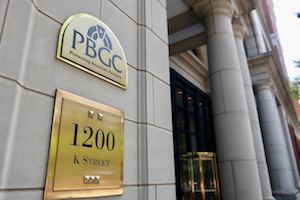 The Pension Benefit Guaranty Corporation (PBGC) on Jan. 25 announced a final rule amending the special financial assistance (SFA) regulation to add an exception process for certain withdrawal liability conditions that apply to a plan that receives SFA. The final rule is effective Jan. 26, 2023.
The Pension Benefit Guaranty Corporation (PBGC) on Jan. 25 announced a final rule amending the special financial assistance (SFA) regulation to add an exception process for certain withdrawal liability conditions that apply to a plan that receives SFA. The final rule is effective Jan. 26, 2023.
The PBGC made the amendments in response to public comments it received concerning the SFA final rule published in July
The rule:
- sets forth what information a plan is required to file to demonstrate eligibility for SFA and the formula to determine the amount of SFA that the PBGC will pay to an eligible plan;
- outlines a processing system, which will accommodate the filing and review of many applications in a limited amount of time; and
- specifies permissible investments for SFA funds and establishes certain restrictions and conditions on plans that receive SFA.
The Amendment
One commenter requested that PBGC grant exceptions from or modifications to the withdrawal liability conditions for plans that have unique facts and circumstances — such as a plan that uses an alternative withdrawal liability allocation method — if applying the condition to the plan would result in a lower assessment of withdrawal liability, thereby encouraging contributing employers to withdraw.
After considering the comment, the PBGC determined that adding a process for a plan to request an exception from the withdrawal liability conditions under narrow circumstances is reasonable. Accordingly, the PBGC is adding a process by which a plan sponsor can request PBGC approval for an exception from the withdrawal liability conditions under specific circumstances.
Under the exception process, a plan sponsor may request an exception from the withdrawal liability conditions by demonstrating to the satisfaction of PBGC that the exception lessens the risk of loss to plan participants and beneficiaries and does not increase expected employer withdrawals. The plan sponsor must also demonstrate that the exception does not increase the amount of the plan’s SFA or unreasonably increase the PBGC’s risk of loss. The plan sponsor or its duly authorized representative must submit a request for PBGC approval of an exception, and it must contain required identifying, actuarial, and financial information.
A request for an exception from the withdrawal liability conditions may be submitted to PBGC either before the plan’s initial application for SFA is filed or before a revised application is filed. The PBGC encourages a plan sponsor requesting an exception to have a pre-submission consultation with the agency first.
When an application for SFA is prepared, a plan must take plan assets into account in determining the amount of requested SFA. This includes withdrawal liability payments made and expected to be made to the plan during the SFA coverage period taking into account a reasonable allowance for amounts considered uncollectible. Accordingly, if a plan sponsor submits a request for an exception from the withdrawal liability conditions, the plan’s application for SFA must take the exception into account in the determination of the withdrawal liability payments expected to be made to the plan and the amount of requested SFA.
The PBGC adds that the exception process added by this final rule is separate from the SFA application process.
More to Come?
The PBGC said that two commenters requested it review the impact on the assessment of withdrawal liability when a plan that receives SFA is deemed to be in critical status through 2051. One suggested that the PBGC add a condition to require plans that receive SFA to include contribution increases under a rehabilitation plan for withdrawal liability purposes.
The PBGC says this issue raises interpretive issues about Sections 305(g)(3), 305(d)(1)(B), and 305(f)(1)(B) of ERISA over which the Secretary of the Treasury has interpretive jurisdiction under Section 101 of Reorganization Plan No. 4 of 1978 (5 U.S.C. App.). The PBGC says it is continuing to examine these issues with the Department of the Treasury and if appropriate, may issue additional guidance if it is appropriate to do so.
- Log in to post comments
